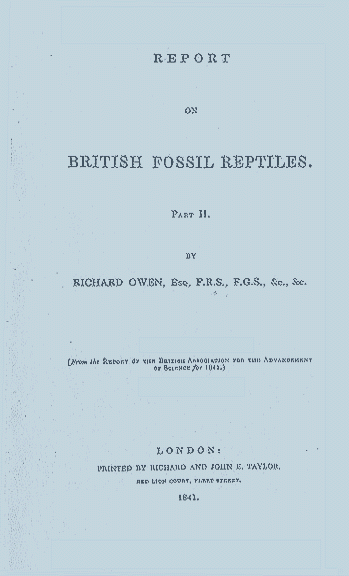

 | SIR RICHARD OWEN: British paleontologist and zoologist (1804-1892). Hunterian Professor in comparative anatomy at the Royal College of Surgeons, and tutor of Queen Victoria's children. He was extremely influential in the decades prior to the publication of Darwin's Origin of Species in 1859, and maintained an active and highly visible position in the scientific world, but because he could not accept Darwin's ideas about evolution, his influence waned considerably after the appearance of Darwin's great book. Owen made major contributions in a variety of areas. He is shown in the picture at left holding in his right hand the shell of the modern pearly nautilus, Nautilus pompilius . His left hand rests near a bottle holding the body of the animal preserved in alcohol. Owen wrote the first anatomical description of Nautilus using a pickled specimen brought to him by colleagues who had collected it in the southwestern Pacific which still has, in the Philippines, New Guinea, and Micronesia, a large population of these unusual animals. Owen's treatise on Nautilus was so insightful that it is still used by modern zoologists and paleontologists who work on these animals and their fossil relatives. |
 | Owen was also a major contributor to the study
of dinosaurs during the 1830's, 40's and 50's, and published many important papers on these
animals during this period. He raised questions about dinosaurs which are
still controversial today, most notably, perhaps, the idea that dinosaurs may have been
warm-blooded (like mammals and birds) rather than cold-blooded like other reptiles.
However, none of Owen's work, exceeds in significance his paper
in the 1842 issue of the scientific journal called the British Association for the
Advancement of Science (BAAS), because it is here that dinosaurs are first scientifically
defined and named. It was Owen who established dinosaurs as an extinct group of fossil
reptiles distinct from modern reptiles. And it was he who invented the word "Dinosaur" as
the name for these fossil reptiles. The passage from this paper in which he does this is
reproduced below - in Owen's typically convoluted Victorian prose style.
"The combination of such characters, some, as the sacral bones, altogether peculiar among reptiles, others borrowed, as it were, from groups now distinct from each other, and all manifested by creatures far surpassing in size the largest of existing reptiles, will, it is presumed, be deemed sufficient ground for establishing a distinct tribe or suborder of Saurian Reptiles, for which I would propose the name of Dinosauria." |
 | Owen was the first scientist to bring dinosaurs to the notice of the public in a major way. He teamed up with Benjamin Waterhouse Hawkins, a contemporary British sculptor, to produce for public display what Owen thought were realistic, life size models of the few dinosaur species that were known at the time (e.g. Iguanodon, Megalosaurus). Being quite the showman, Owen in one case held an important BAAS dinner meeting inside one of these models, a print of which is shown at left. The British public loved it. Owen had more than his share of egomania, with the result that he was an extremely difficult person to deal with. He created many enemies - usually unnecessarily. He had a longstanding, and particularly bitter dispute with Gideon Mantell, ostensibly because Mantell proposed that Iguanodon was 200 feet long, and Owen thought it was smaller (Owen was right). The fact that Owen was a part of the upperclass, urban, establishment while Mantell was a self-taught, self-supporting provincial was probably the actual cause, however. Owen tried to suppress Mantell at every turn, including lobbying to block the presentation of the Royal Society's Royal Medal to Mantell for his work on dinosaurs. The intercession of Charles Lyell, the greatest geologist of the day and confidante of Charles Darwin, saved the day for Mantell. The feud only ended with Mantell's death in 1852. |